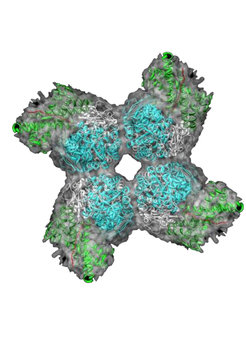
Press Page Manajit Hayer-Hartl
Rebuilding a Protein in the Test Tube
Proteins can fulfill their complex biological functions only if they have acquired their correct three-dimensional structure. The folding process is mediated by molecular chaperones. These can also assist in re-creating proteins in the test tube. Manajit Hayer-Hartl and her team have succeeded in reconstructing the key protein of photosynthesis.

Proteins have many essential functions within the cell, for instance as enzymes or transport molecules or in other vital processes. Such as photosynthesis: Plants turn carbon dioxide and water into oxygen and sugar. One of the proteins that is critical in this process is Rubisco. It takes up carbon dioxide from the atmosphere to synthesize sugar molecules that then serve as building material for cells and tissues. Hence, Rubisco is one of the most important proteins of all. However, it can only fulfill its task if it has the correct structure.
Folding assistants on duty
In all, Rubisco consists of 16 subunits. Up to now, its complex structure made it impossible to rebuild it in the test tube. Manajit Hayer-Hartl discovered that the assembly of Rubisco depends on a special type of chaperone, called RbcX. RbcX staples the large subunits of Rubisco together until they can form a functional complex with the small subunits.
Improved performance for the environment
The next step would be to change the Rubisco protein so that it becomes more effective in the uptake of carbon dioxide than the natural protein. As a more effective enzyme, Rubisco could then take up more carbon dioxide from the atmosphere. Hence, the work of the scientists could also help in climate protection.



